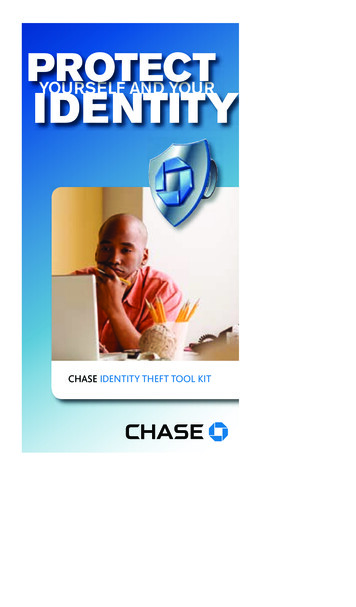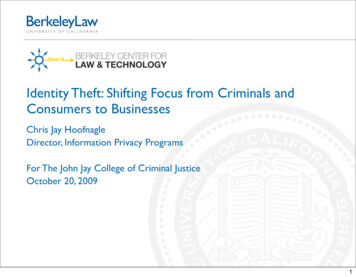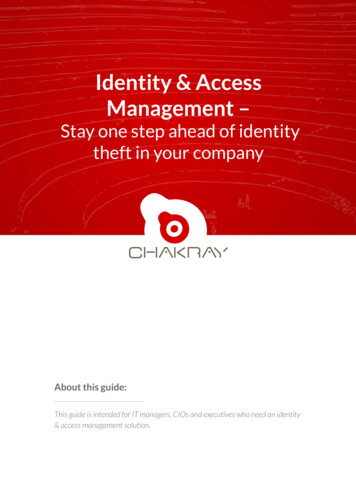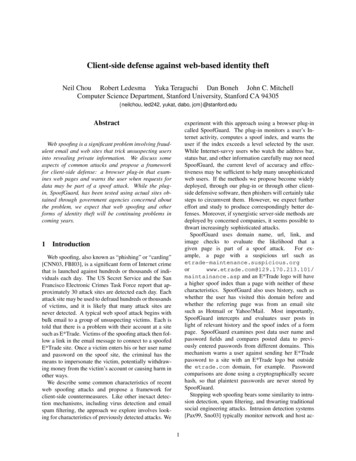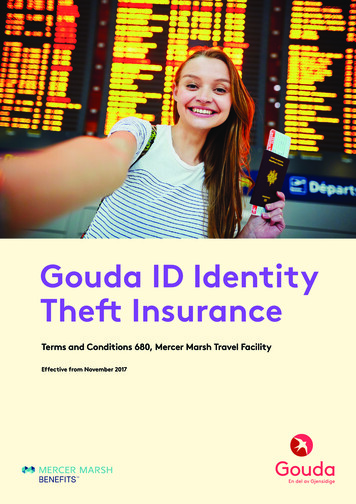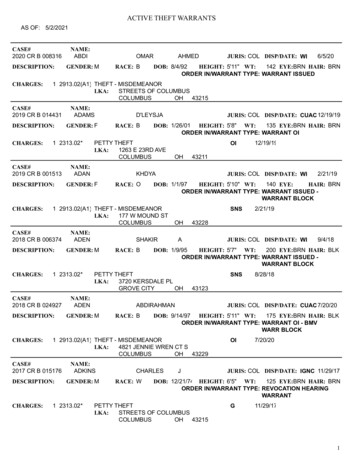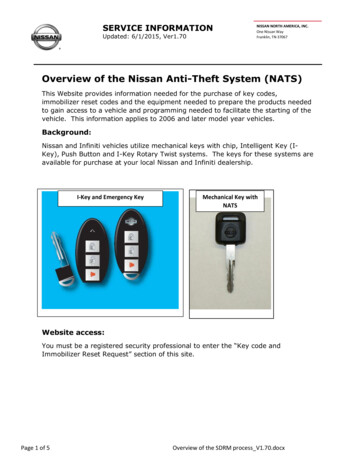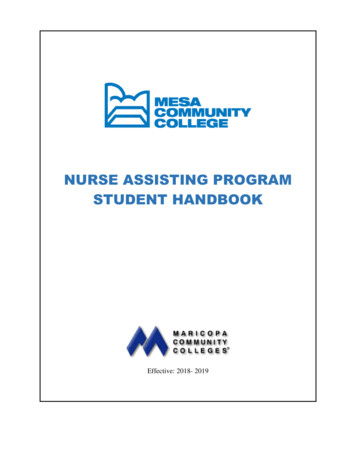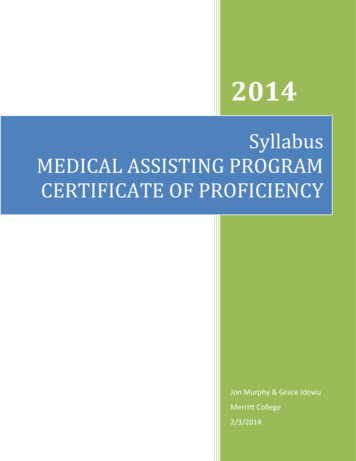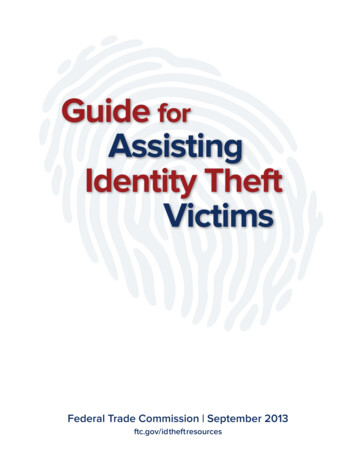
Transcription
Guide forAssistingIdentity TheftVictimsFederal Trade Commission September 2013ftc.gov/idtheftresources
Table of ContentsTable of Contents . 1I.Overview . 3II.Understanding Identity Theft and How to Assist its Victims . 4The Initial Screening Call .6Preparing for a First Meeting .9The Intake Meeting .10Making an Action Plan .10Attorney Intervention .15Private Rights of Action and Consumer Protection Remedies .16III. The Primary Tools for Victims. 17Primary Tools To Minimize Further Fraud .17Primary Tools to Show That the Victim is Not Responsible for the Fraud and to Correct Credit Reports .20IV. Addressing Account-Related Identity Theft . 25Blocking Information in Credit Reports (under Sections 605B and 623(a)(6)) .26Disputing Errors in Credit Reports (Under Sections 611, 623(b), and 623(a)(1)(B)).29Disputing Fraudulent Transactions with Banks and Creditors .31Disputing Fraudulent Transactions with Check Verification Companies .31Dealing with Debt Collectors Seeking Payment for Accounts Opened or Misused by an Identity Thief .38Obtaining Business Records Relating to Identity Theft .40V. Addressing Other Forms of Identity Theft. 42Identity Theft & Children .42Criminal Identity Theft .42Identity Theft Involving Federal Student Loans.43Identity Theft Involving the Internal Revenue Service .45Identity Theft Involving the Social Security Administration .45Medical Identity Theft .46The “Other” Consumer Reports: “Specialty” Consumer Reports .46Appendix A: Key Identity Theft Concepts and Tools . 47Glossary .48Free Annual Credit Reports and Other Free Reports .53Proof of Identity .56Authorization Form for Attorneys .581
Online Resources for Attorneys and Victim Service Providers .59Appendix B: Checklists . 61List of Sample Questions for Intake Interview .62Checklist for General Steps Addressing Identity Theft .66Checklist - Blocking Fraudulent Information from Credit Reports, Credit Reporting Agencies’ Obligationsunder FCRA Section 605B .71Checklist - Debt Collectors’ Obligations under FCRA Sections 615(f), (g) and FDCPA Sections 805(c), 809(b).74Appendix C: Sample Letters . 76Blocking Request Letters Under §§ 605B and 623(a)(6)(B) .77Dispute Letters Under §§ 611 and 623.90Disputing Fraudulent Transactions with Check Verification Companies .99Disputing Fraudulent ATM and Debit Card Transactions .103Credit Card Issuer Obligations under the FCBA .109Disputing Fraudulent Charges and New Accounts with Other Creditors .112Disputing Debts Resulting From Identity Theft with Debt Collectors .117Obtaining Business Records Relating to Identity Theft .123Appendix D: Core Consumer Educational Materials . 129Recommended Identity Theft Materials .129Appendix E: Federal Statutes and Regulations . 130The Fair Credit Reporting Act (FCRA) .130Other Statues & Regulations .1302
I.OverviewThis Guide, prepared by the Federal Trade Commission (FTC), is intended to assist attorneyscounseling identity theft victims. It explains: common types of identity theft the impact of identity theft on clients the tools available for restoring victims to their pre-crime status.Specifically, the Guide highlights the rights and remedies available to identity theft victimsunder federal laws, most notably: the Fair Credit Reporting Act (FCRA) the Fair Credit Billing Act (FCBA) the Fair Debt Collection Practices Act (FDCPA) the Electronic Funds Transfer Act (EFTA).It also includes information and materials published by other organizations that address lesscommon, more complex, and emerging forms of identity theft, such as medical or employmentrelated identity theft.3
II.Understanding Identity Theft andHow to Assist its VictimsEach year, millions of Americans discover that a criminal has fraudulently used their personalinformation to obtain goods and services and that they have become victims of identity theft.Under federal law, identity theft occurs when someone uses or attempts to use the sensitivepersonal information of another person to commit fraud. A wide range of sensitive personalinformation can be used to commit identity theft, including a person’s name, address, date ofbirth, Social Security number (SSN), driver’s license number, credit card and bank accountnumbers, phone numbers, and even biometric data like fingerprints and iris scans.New & Existing Financial AccountsThe most common form of identity theft, and the main focus of this Guide, involves thefraudulent use of a victim’s personal information for financial gain. There are two main types ofsuch financial frauds: Using the victim’s existing credit, bank, or other accounts A victim of existing account misuse often can resolve problems directly with thefinancial institution, which will consider the victim’s prior relationship with theinstitution and the victim’s typical spending and payment patterns. Opening new accounts in the victim’s name A victim of new account identity theft usually has no preexisting relationship withthe creditor to help prove she is not responsible for the debts. The new account usually is reported to one or more credit reporting agencies(CRA), where it then appears on the victim’s credit report. Since the thief doesnot pay the bills, the account goes to collections and appears as a bad debt onthe victim’s credit report. Often, the victim does not discover the existence ofthe account until it is in collection. The victim must prove to the creditor that she is not responsible for the accountand clear the bad debt information from her credit report.Many times victims experience both.Other types of identity theft are listed in the Glossary.4
The Goals for VictimsThis Guide will help you assist a victim achieve three goals:1. stopping or minimizing further fraud from occurring2. proving that identity theft has occurred and that the victim is not responsible for debtsincurred in her name and3. correcting any errors on the victim’s credit report to restore her financial reputation andcredit scoreThe Guide initially assumes a worst-case scenario, where the victim has experienced newaccount identity theft, and a fraudulent new account has been added to her credit report. Itpresents simpler alternatives for victims who have not experienced new account identity theftand who typically do not need to clear their credit report.Guiding vs. Hands-onThe Guide also assumes that many victims of identity theft are able to resolve their concerns ontheir own, once they have been told about the steps they need to take.RECOMMENDED APPROACH:Encourage most victims to take as many steps as possible on their own, and offer to stay intouch to monitor success and provide additional assistance as needed.SPECIAL CASES:In some instances, however, it may be clear from the initial screening call that the victim will beunable to undo the harms caused by the theft of her identity. Victims may need yourimmediate direct assistance when: their age, health, language proficiency, or economic situation create barriers forthem in disputing and correcting errors in their records they are sued by creditors attempting to collect debts incurred by an impostor they are being harassed by creditors attempting to collect debts incurred by animpostor creditors or CRAs are being uncooperative their case is complex or involves non-financial identity theftVulnerability & Emotional NeedsVictims who have experienced the more serious forms of identity theft often report emotionalharm, including feeling an enormous sense of vulnerability and a diminished trust in others.The Office of Victims of Crime has a tutorial on interviewing identity theft victims with tips onhow to attune your approach to their emotional needs. You and those in your office who willbe interacting with identity theft victims may want to go through the tutorial.5
The Initial Screening CallWhen a victim contacts your office, you will need to gather the facts to determine if identitytheft has occurred, whether the victim needs your immediate direct assistance, and whatassistance, if any, your office may provide. To make these determinations, ask the followingquestions: What facts lead the caller to believe that her personal information has beenmisused? How and where did the identity thief misuse the information? When and how did the caller discover the misuse or fraud? What harm has the caller suffered as a result of the identity theft?First Steps with a VictimIf you confirm that the caller is an identity theft victim, advise her to take the following stepsimmediately to prevent further harm, whether the identity theft involves new or existingaccounts:2. place an initial fraud alert on her credit reports3. obtain and reviewing her credit reports for evidence of additional identity theft and,4. cancel any compromised bank, credit card, or other accountsYou also may wish to: provide the caller with additional resources, as described below. advise her of the importance of documenting her efforts6
1. Placing an Initial Fraud AlertPlacing an initial fraud alert on credit reports will reduce the risk that an identity thief will opennew accounts in the victim’s name. An initial fraud alert stays on the victim’s credit file for 90days, and can be renewed every 90 days. Identity theft victims can place an initial 90-day fraudalert by contacting one of the following three CRAs. That
her products or services, such as credit monitoring or identity theft insurance. For more information on these products, see “ Identity Theft Protection Services ”. Later, when the victim calls the CRA to order the free credit report she is entitled to in conjunction with the fraud alert, the CRA may first direct the victim’s attention to
